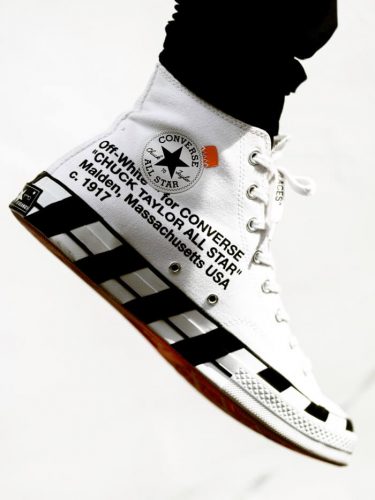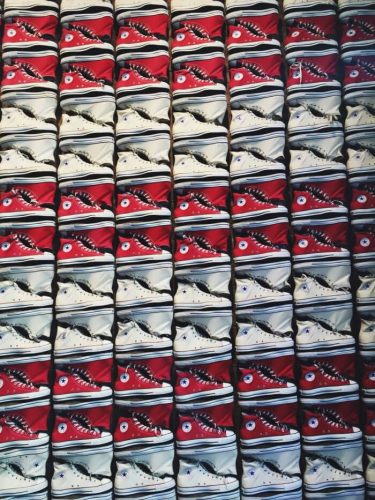When you think of classic basketball shoes, do you picture NBA stars cruising down the court in those classic leather high-tops? If so, then you might be imagining timeless Converse Pro Leather sneakers.
For more than 45 years, these shoes have graced the feet of some of the industry’s elite, as well as commoners who want to stand out on the street or in the gym.
The history of the Converse Pro is as rich and intricate as the pair themselves. Today, we’re sharing how the sneaker came to be and the impact it’s made on sports history.
1976: When It All Began

In the late 1970s, Converse was on the cusp of making sneaker history. It was that year that the brand released its instant hit, the All-Star Professional Basketball Shoe.
Made of prime materials and built to last, the shoe would have stood on its own. However, it was one early endorsement from superstar Julius Erving that catapulted the sneakers to fame and glory.
From that moment forward, the All-Star shoes were nicknamed the “Dr. J” and they began to fly off the shelves. At the time, the cupsole on those shoes was the lightest and most technologically advanced on the market, offering buyers something totally different and innovative.
It was the first to debut a sole unit stitched directly to the bottom of the shoe itself, adding extra responsiveness and durability to each pair. Before then, most basketball shoes had only a piece of rubber affixed to the base, with a thin strip around the midsole. Those materials were melded together to form a cohesive unit.
With the release of the All-Stars, Converse had made a new pattern and set a new trend. Players were able to keep pace with the recent resurgence of speed found in basketball, where games were won based on a player’s ability to dominate the court and move as quickly as possible.
Branding in Action
Piggybacking off the success of the All-Star’s original debut, Converse decided to introduce a special colorway. This version was all-white and featured the brand’s recognizable Chevron logo in a neutral tone.
While it might have seemed bland, the colorway was anything but. With every purchase, wearers would also receive a set of special markers. They could then use those markers to color the Chevron stripes to match their favorite team.
While personalized sneakers are still white-hot today, this was one of the first applications that truly changed the market for the better.
This new colorway wasn’t the only change that happened in the year following the All-Star release. In 1977, Converse modified the design of the shoe slightly. While the original design was somewhat tapered in thickness, this one was more uniform. The branding and logo were also bolder and more prominent.
Other Design Changes to Note
As the years went by, the sneakers went through a few more changes, although their basic form and function remained the same. Toward the end of the 1970s, Converse removed the padding out of the tongue. This made the piece thinner and made it easier for players to move their ankles while they played.
In addition, the silhouette of the shoe also became slimmer in time, and the upper portion received extra reinforcement around the ankle. Yet, perhaps the most notifiable change came when Converse changed the upper material from the original canvas.
Newer models showcased a special type of leather that was coated in urethane. The new surface was more scratch-resistant and held up better both on and off the court. Thus, the name Converse Pro Leather was born.
Today, you can find the entire Converse Pro Leather collection online, through reputable retailers that offer authentic products. If you’re interested in purchasing a pair for your own feet, click for more information.
Mid-Eighties: Leaving the Game
Although they were on a long upswing, the Converse Pro Leather eventually left the game. Yet, it wasn’t another competing sneaker brand that inched the shoe out. Rather, it was Converse itself!
The company had been hard at work creating a biomechanics laboratory focusing specifically on improving the performance of athleticwear. It was the first lab of its kind in the industry, and it paved the way for some impressive inventions.
Out of that lab, Converse researchers began churning out new technology that made their sneakers more comfortable and better-performing than ever before. Among the many improvements, some of the most memorable were:
- Improved midsole cushioning
- More responsive, energy-return components
- Motion control devices
The brand began releasing new shoes, new colorways, and new lines. One was called StarTech and released in 1985. Heralded as one of the best Converse shoes ever made, the StarTech became “the” shoe for many basketball teams across the nation, including:
- North Carolina
- University of Louisville
- Georgia Tech
- Louisiana State University
Like the original All-Star shoes, some StarTech sneakers allowed wearers to color in a portion of the all-white colorway with the colors they chose. With so many options and such improved technology, these new shoes were inching closer to the spotlight, and the Converse Pro was slipping away.
While features like the cupsole were creative at their time, they were no match for the new materials and construction that defined the latest Converse lines. While the brand eventually phased the shoe out, its place in history was far from erased.
A New Generation Takes Note
Though the late 1980s weren’t particularly kind to the Converse Pros, they were about to see a major resurgence in two different realms. First, they became iconic as the shoe of choice in the underground hip-hop world. Not only did wearers clamor for the leather versions, but they also coveted the original canvas shoes, too.
Before long, the skater scene took note. The shoes were surprisingly durable, which they needed in their sport. Industry elite like Rodney Mullen and Guy Mariano wore them, along with a similar shoe, the Converse One Star.
Today, you can still find Converse Pro sneakers online, along with other great releases from the brand. In 2008, Converse celebrated 100 years in the business and brought back the original 1976 version of the All-Star shoe.
NBA Greats in Converse Pro Leather
As mentioned, Julius Erving was one of the first NBA players to wear and remark on the Converse sneakers. However, he wasn’t the only one. Magic Johnson also wore the shoe in 1980 while in the same championship game as Erving’s now-famous baseline reverse layup.
In fact, Johnson went on to win Finals MVP, wearing the very same sneakers. Then, when Larry Bird was drafted to the Celtics, he chose the original canvas version, though the Leather Pro was already in rotation. At that time, Bird’s move was the highest-paying rookie contract in the history of the NBA.
Erving, Johnson, and Bird proudly wore their Converse sneakers in every game, with the Chevron logo front and center. As they were living into their glory, there was another up-and-comer who was preparing to change the league in the very best way.
Michael Jordan Makes His TV and Converse Debut
Michael Jordan switched to the Converse Pro Leathers toward the tail end of his college basketball career. The shoes were on his feet when he hit the final-second, winning shot in the North Carolina NCAA championship game in 1982. In that game, Jordan led the Carolina Tar Heels in a 63 to 62 victory over the Georgetown Hoyas, although there’s still some debate over who should get the credit for the win.
The game was Jordan’s first performance on television, and he put on quite the show. Flying all over the court and showcasing impressive moves, Jordan’s feet took center stage. Based on his performance alone, the shoes had a new moniker.
Suddenly, the “Dr. Js” became known as the “Buzzer Beaters”, a name that paid homage to Jordan’s last-minute save at the championship game. When Jordan was drafted into the NBA two years later, you can guess which shoes were on his feet.
He also rocked them on the Olympic podium during his rookie year after his team took the gold. When the shoe fits, why stray? In some of the most pivotal moments in young Jordan’s fledgling career, the Converse Pro Leathers had a front-row seat.
Some reports even claim that Jordan tried to sign with Converse as a brand rep once he joined the NBA. Instead, that honor would eventually go to Nike.
If that wished-for deal would have gone through, it would have changed shoe history forever. Who knows if we would have the iconic Air Jordans that we know and love today?
Find Your Favorite Converse Pro Leather Sneakers Today

Now that you know the Converse Pro Leather backstory, are you ready to add a few new pairs to your collection? One of the most prolific basketball shoes in history, these sneakers went on to become royalty in the hip-hop, skater, and youth culture world.
Whether you rock an all-white version or a more vibrant colorway, be sure to do so with confidence. Much of what made superstars like Irving and Jordan so great was their innate swagger, which shoes like this help you deliver.
Looking for more helpful news and advice? Check out our Sports and Fitness section!







